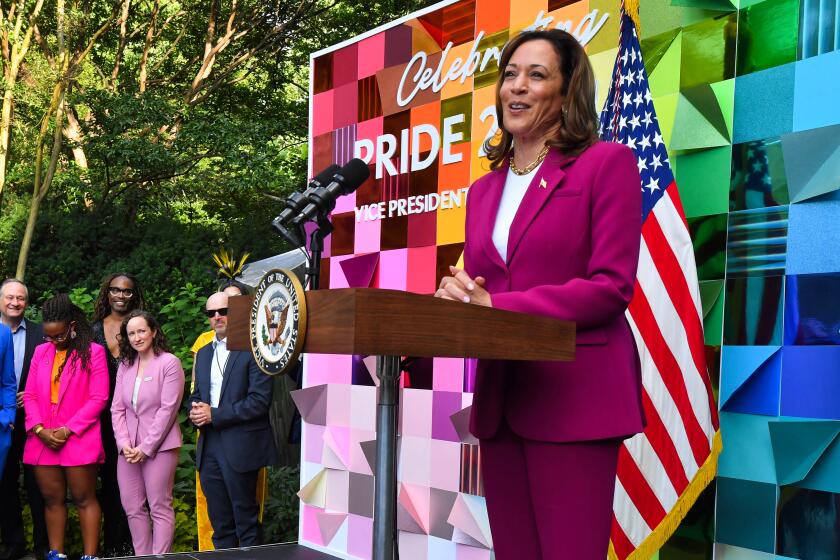Westside Expected to Lose in Senate Remap : Politics: Population in the area has failed to keep pace with statewide growth. Consequently, some boundaries for the heavily Democratic seats could be shifted.
Los Angeles County’s Westside state Senate districts are expected to be among the losers in this decade’s version of the California reapportionment numbers game.
The political arithmetic goes like this: Based on 1990 census data, each of the state’s 40 Senate districts must contain 744,000 people. To reach that magic number, the four Senate districts on the Westside all need to add thousands of new constituents because population in the area has failed to keep pace with statewide growth patterns. In some cases, it has actually dropped.
Consequently, some of the boundaries for these heavily Democratic seats could be combined or shifted eastward. That could cost one or more of the incumbents their jobs. And it could trigger a ripple effect that ultimately boosts representation in such fast-growing, Republican-leaning areas as the Antelope and San Gabriel valleys and Riverside and San Bernardino counties.
“People are moving to the Inland Empire, Lancaster and Palmdale,” said Sen. Diane Watson (D-Los Angeles). “They are moving out of the urban core.”
Watson and Democrats Herschel Rosenthal and David A. Roberti, both of Los Angeles, represent virtually all of West Los Angeles, Culver City, Beverly Hills, West Hollywood and Hollywood. The district of the fourth senator, Democrat Gary Hart of Santa Barbara, dips into Malibu from the north.
Although politicians can artfully design boundaries to ensure safe seats for many incumbents, including those facing population deficits in their districts, one fact in the reapportionment puzzle is inescapable: Growth in inland areas is dramatically outstripping growth in the coastal plain.
And that probably means redistricting problems for at least a few lawmakers in slow- or no-growth areas. As Sen. Bill Leonard (R-Big Bear) notes, “Political power sooner or later does follow the population.” His district includes booming areas in the San Gabriel Valley and San Bernardino County.
Statewide, one result of the redistricting process could be a cut in the Democratic majority in the Senate, where the current lineup is 26 Democrats, 11 Republicans, and one independent, with two vacancies.
Los Angeles County, now represented by all or part of 17 Senate districts, could lose the equivalent of one full seat, according to lawmakers and legislative staffers. And though the exact shape of the districts will not be decided for months, on the Westside the result probably will be a diminishment of representation in the Senate.
Historically, as population grew in Los Angeles during most of this century, reapportionment turf fights revolved around skirmishes between Northern and Southern California. Now, given the population shifts within Southern California, the battle lines probably will pit the interests of such established coastal communities as Santa Monica and Marina del Rey against the fast-growing inland areas.
“With the population static on most of the coast and ballooning inland . . . that will definitely tip the scales of power to the inland counties,” said Assemblyman Pat Nolan (R-Glendale), a member of the Assembly Elections, Reapportionment and Constitutional Amendments Committee, which is currently crafting a redistricting plan.
A look at census figures highlights why legislative boundaries are expected to be pulled toward the inland areas. For instance, the inland city of Pomona grew a whopping 42% in the 1980s, to 133,107. By comparison, Santa Monica’s population dropped 2%, to 86,905.
Even though the city of Los Angeles grew 17% between 1980 and 1990, the state as a whole grew by 26%. By failing to keep pace with statewide growth, Los Angeles stands to lose representation in the Legislature, according to lawmakers and others beginning to draw the new lines.
Based on the census numbers, the Senate Elections Committee has estimated that Rosenthal’s 22nd District is 78,000 below the 744,000 population figure that the new boundaries need to encompass. The Westside’s other three senators find their districts below that figure by the following amounts: Roberti, in the 23rd District, 63,000; Watson, in the 28th District, 57,700; and Hart, in the 18th District, 24,500.
Comparable population projections for the Assembly and U.S. House of Representatives have not been made public.
Once the Legislature approves a reapportionment plan, it goes to Gov. Pete Wilson for his signature. No matter what Wilson decides, it is widely expected that the final maps will face court challenges, especially from Latino or Asian groups seeking increased minority representation.
Reviewing the preliminary numbers for the Senate districts, some lawmakers have already cooked up their own formulas to compensate for population deficits they face. For instance, Watson said she would like to swap Hancock Park and the Larchmont area to Rosenthal for Culver City and parts of Mar Vista and Venice.
Watson, who is black, may be in a good position to make such deals because changes in the federal Voting Rights Act require political map makers to take steps to ensure that minority representation is not shortchanged.
Under the act, Watson said, the districts of minority lawmakers “have to be somewhat protected.”
Partly because of this, white senators such as Rosenthal are flirting with running for Congress.
Rosenthal acknowledged he could develop a case of Potomac fever if his Senate district is carved up. He said he may enter the race for the seat held by Rep. Mel Levine (D-Santa Monica) if the congressman decides to run for the U.S. Senate.
“I could conceive of the possibility of running for Congress,” Rosenthal acknowledged. “I’m not looking at it seriously, but the possibility does exist.”
Hart, who unsuccessfully ran for Congress in 1988, also is considered a potential congressional candidate in the Santa Barbara-Ventura area.
And in the South Bay, 81-year-old Sen. Ralph C. Dills (D-Gardena), has said that if his district is dramatically redrawn, he might run for Congress.
The prospect of senators jumping into congressional races is being taken seriously for several reasons. First, term limits for state lawmakers imposed by the passage last year of Proposition 140 have prompted some legislators to contemplate new political opportunities.
Second, in contrast to a decade ago, state legislators plan to exercise more control over the drawing of congressional lines than they did after the 1980 census, according to Nolan.
“Ten years ago they were willing to accept” a plan drawn up by the late Democratic Rep. Philip Burton of San Francisco, Nolan said. But this time, he predicted, they will listen to their congressional colleagues and “then go ahead and draw whatever they want.”
REDRAWING SENATE DISTRICTS
Based on 1990 census figures, new state Senate districts must be redrawn to each represent 744,000 people. The following chart, based on preliminary legislative estimates, shows how current Senate districts on the Westside compare to that number.
Above or Below District Representative Population of 744,000 18 Gary Hart (D-Santa Barbara) -24,500 22 Herschel Rosenthal (D-Los Angeles) -78,000 23 David Roberti (D-Los Angeles) -63,000 28 Diane Watson (D-Los Angeles) -57,700
More to Read
Get the L.A. Times Politics newsletter
Deeply reported insights into legislation, politics and policy from Sacramento, Washington and beyond. In your inbox three times per week.
You may occasionally receive promotional content from the Los Angeles Times.










